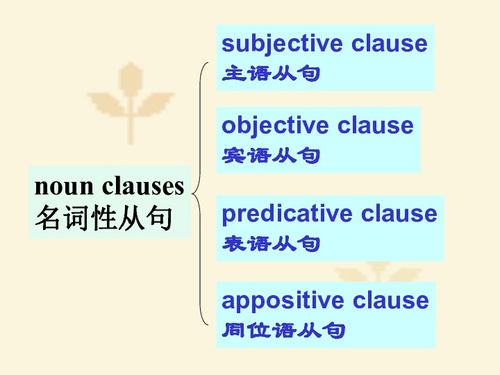
同位语从句英语目录

同位语从句,指的是在复杂句中充当同位语的从句,属于名词性从句的范畴。
同位语从句用来对其前面的名词的内在属性或本质内容进行解释说明,被解释说明的词和同位语在逻辑上是主表关系。
同位语从句通常以when,where,why,who,how,that, whether等连接词来引导。

关于同位语从句的英语语法
1.同位语从句:whether
whether可以引导同位语从句,而定语从句不能用whether作为引导词。
He hasn’t made the decision whether he will go there.
他还没有做出决定是否去那里。
I have small doubt whether he is suitable for the job.
他是否适合这件工作我有点怀疑。
2.同位语从句:that
些名词的后面可以接that引导的同位语从句:
We came to the decision that we must act at once. 我们做出决定:我们必须立即行动。
He made a proposal that the meeting be postpone. 他提议会议延期。
There was little hope that he would survive. 他幸存的希望很小。
在非正式语体中that可以省略。
以下名词常用于以上句型:
advice, announcement, argument, belief, claim, conclusion, decision, evidence, explanation, fact, feeling, hope, idea, impression, information, knowledge, message, news, opinion, order, probability, promise, proposal, remark, reply, report, saying, statement, suggestion, thought, treat, warning, wish, word
3.同位语从句:what
what可以引导同位语从句,而定语从句不能用what作为引导词
I have no idea what he is doing now. 我不知道他现在在干什么。
4.同位语从句:how
how可以引导同位语从句,而定语从句不能用how作为引导词
It’s a question how he did it. 那是一个他如何做了此事的`问题。
5.同位语从句:who等
who, whom, which, when, where, why用来引导同位语从句
The question who should do the work requires consideration.
谁该干这项工作,这个问题需要考虑。
She raised the question where we could get the fund.
她提出这个问题:我们到哪儿去搞这笔资金。
6.同位语从句和定语从句的区别
1)同位语从句和先行词是同等的关系;而定语从句是用来修饰先行词,是从属的关系。
2)that在同位语从句中没有词义,不充当句子成分;而在定语从句中充当主语、宾语等句子成分。
3)whether, what, how可以用来引导同位语从句;而它们不能用来引导定语从句。
;
同位语从句英语目录

同位语从句,指的是在复杂句中充当同位语的从句,属于名词性从句的范畴。
同位语从句用来对其前面的名词的内在属性或本质内容进行解释说明,被解释说明的词和同位语在逻辑上是主表关系。
同位语从句通常以when,where,why,who,how,that, whether等连接词来引导。

关于同位语从句的英语语法
1.同位语从句:whether
whether可以引导同位语从句,而定语从句不能用whether作为引导词。
He hasn’t made the decision whether he will go there.
他还没有做出决定是否去那里。
I have small doubt whether he is suitable for the job.
他是否适合这件工作我有点怀疑。
2.同位语从句:that
些名词的后面可以接that引导的同位语从句:
We came to the decision that we must act at once. 我们做出决定:我们必须立即行动。
He made a proposal that the meeting be postpone. 他提议会议延期。
There was little hope that he would survive. 他幸存的希望很小。
在非正式语体中that可以省略。
以下名词常用于以上句型:
advice, announcement, argument, belief, claim, conclusion, decision, evidence, explanation, fact, feeling, hope, idea, impression, information, knowledge, message, news, opinion, order, probability, promise, proposal, remark, reply, report, saying, statement, suggestion, thought, treat, warning, wish, word
3.同位语从句:what
what可以引导同位语从句,而定语从句不能用what作为引导词
I have no idea what he is doing now. 我不知道他现在在干什么。
4.同位语从句:how
how可以引导同位语从句,而定语从句不能用how作为引导词
It’s a question how he did it. 那是一个他如何做了此事的`问题。
5.同位语从句:who等
who, whom, which, when, where, why用来引导同位语从句
The question who should do the work requires consideration.
谁该干这项工作,这个问题需要考虑。
She raised the question where we could get the fund.
她提出这个问题:我们到哪儿去搞这笔资金。
6.同位语从句和定语从句的区别
1)同位语从句和先行词是同等的关系;而定语从句是用来修饰先行词,是从属的关系。
2)that在同位语从句中没有词义,不充当句子成分;而在定语从句中充当主语、宾语等句子成分。
3)whether, what, how可以用来引导同位语从句;而它们不能用来引导定语从句。
;